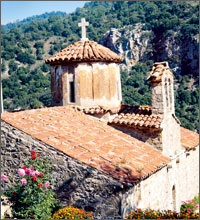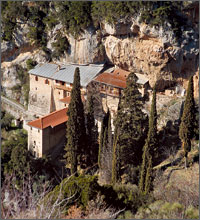Picture: www.kathimerini.gr
The Peloponnesian Athos is situated below the historical villages of Stemnitsa and Dimitsana.
The Valley of the Lousios River is indescribably beautiful. Vegetation covers its steep slopes and the waters of the river pass through scenic thresholds before emptying into Alfios near Karitena. The river is mythical because Zeus used to bathe in it. Today, Lousios’s religious monuments, which are among the most important in the Greek history, are kept alive by a few monks.
Emialon Monastery
On the main road connecting Dimitsana and Stemnitsa, just after the interesting Open Air water power Museum, one can find Emialon Monastery. It was built on a perpendicular cliff among cypresses. The tower of the monastery, in the form of the letter "T", was once a defensive tower with battlements, and now it is an inn.
Emialon Monastery is small; it was founded in the late 16th - early 17th century by monk Grigorios’s brother and sister, as well as nun Efpraksia Kondoyani. Because of the caves and ruins of an older temple further up, it is believed that ascetics lived here even before the establishment of the monastery. The name probably comes from Emialos that sounds almost like "omalos" and the monastery was also known as Omalon or Omialon. It played a crucial role in preserving the Greek language and traditions during the Ottoman rule. Six warriors of Kolokotronis died here when Turks laid an ambush, and Theodoros Kolokotronis himself escaped. When in 1834 many monasteries were destroyed, this one accommodated 18 monks.
In the 19th century, it declined and lost all its property except for a famous vineyard. Now, it is a convent of the Monastery of Prodromos and accepts visitors. Its 17th century mural paintings are very impressive – they were painted by famous painters Dimitrios and George Moshos. Monks will treat you with Turkish delight and ice-cold spring water. The view from the small wooden balcony and tranquillity that reigns here will soothe even the most troubled soul.
Prodromos Monastery
 The road to Stemnitsa after Emialon Monastery descends to the village of Elliniko and famous monastery "St. Ioannis Prodromos" (John the Baptist). You can leave your car and walk among the dense vegetation and you will see the monastery literally hanging on a cliff some 200 metres above the Lousios River. The four-storey building is reminiscent of a nest. It is not known exactly when it was founded. Maybe it was in 1545, but a document from 1828, describing the monastery’s property, reads that it was founded 700 years ago. It is a fact, however, that in 1834 it fell apart and the sacred books, vessels and relics of St. Athanasius, Archbishop of Christianopol, disappeared. Monks managed to save documents from 1616 to 1831. Today's Catholicon of the monastery once gathered on Sundays and holidays all the monks and hermits who lived in caves on inaccessible cliffs of Lousios for confession and service. Later, the main temple was built.
The road to Stemnitsa after Emialon Monastery descends to the village of Elliniko and famous monastery "St. Ioannis Prodromos" (John the Baptist). You can leave your car and walk among the dense vegetation and you will see the monastery literally hanging on a cliff some 200 metres above the Lousios River. The four-storey building is reminiscent of a nest. It is not known exactly when it was founded. Maybe it was in 1545, but a document from 1828, describing the monastery’s property, reads that it was founded 700 years ago. It is a fact, however, that in 1834 it fell apart and the sacred books, vessels and relics of St. Athanasius, Archbishop of Christianopol, disappeared. Monks managed to save documents from 1616 to 1831. Today's Catholicon of the monastery once gathered on Sundays and holidays all the monks and hermits who lived in caves on inaccessible cliffs of Lousios for confession and service. Later, the main temple was built.
The monastery contributed to the preservation of Orthodoxy, and its monastery school – to the preservation of the Greek language. It also functioned as a hospital during the war. In 1779, it managed to rescue many women and children from the siege of Albanians. During the Greek Revolution, the abbot aided the rebels at night. From 1976 to 1982, there was a school for priests here. The frescoes are of the Cretan School and were painted in the 16th century.
Philosophou Monastery
A wooden bridge connects the two monasteries - Prodromos and Philosophou. The most famous monastery in the area and one of the oldest in Greece, also known as "The Lord of the Gorge", is located 11 km away from Dimitsana. It consists of two complexes of buildings. The old one dates back to 963-967 and the new is from 1691. It was named after Secretary General of Emperor Nicephorus Phocas, Ioannis Lambardopoulos, also known as the Philosopher. And because it was the only monastery in the region for a long time, it played an important role in the Christianisation of the Slavs who lived here.
 It was also a school for monks and patriarchs such as Gregory VI and Germanos. There was a small school, which can be seen if you follow the path, starting from the monastery. Some 800 metres further down, you will find a cave of length 130 m and width from 0.50 to 8 m. A dark corridor leads to a small church and the place where monks kept the Greek language alive. The monastery was a spiritual centre, and, in 1765, it accommodated the School of Greek Literature, which later moved to Dimitsana. Its library of manuscripts from the 12th century, which are now in the National Library, was also important.
It was also a school for monks and patriarchs such as Gregory VI and Germanos. There was a small school, which can be seen if you follow the path, starting from the monastery. Some 800 metres further down, you will find a cave of length 130 m and width from 0.50 to 8 m. A dark corridor leads to a small church and the place where monks kept the Greek language alive. The monastery was a spiritual centre, and, in 1765, it accommodated the School of Greek Literature, which later moved to Dimitsana. Its library of manuscripts from the 12th century, which are now in the National Library, was also important.
In 1691, the church of the New Monastery was established as a convent of the old one. Because of the small number of monks, Philosophou Monastery also followed the fate of the other 400 monasteries which fell apart in 1834. In 1990, its recovery started. Now, it is taken care of by monk Theophilos who welcomes thousands of visitors, especially on major holidays.
Near the monastery, you can also find the Byzantine stone church "St. Andrew" from the 11th century.
When you pass through the village of Atsiholos, you will see the picturesque monastery of Kalamiou. These are actually two monasteries dedicated to the Assumption. They are located on the right bank of Lousios and are reminiscent of the two Philosophou monasteries. The old one was probably founded in 1705. It is surrounded by walls and battlements and resembles a castle. During the Greek Revolution, it was burned by Ibrahim in 1826. Now it has been restored and celebrates on 15 August.
How to get there
Along the Corinth - Tripoli Highway. At the first kilometre, signs indicate Vitina-Dimitsana (215 km from Athens). Emialon Monastery is 4 km away from Dimitsana, 12 km from Prodromos, and the distance between Prodromos and Philosophou is 11 km. Kalamiou Monastery is 4 km from Atsiholos village.
Where to stay
Staying in Dimitsana is the easiest choice.
Xeniou Tower (phone: 27950-31750, http://www.proselinos.gr/english/)
A remarkable five-storey tower from 1850, with high painted ceilings and antique furniture
Xenonas kaza (phone: 27950-31084, http://www.xenonaskaza.gr/index_en.html)
A comfortable house with 13 rooms and a central lounge with a fireplace
Dimitsana Hotel (phone: 7950-31518)
A renovated hotel with a unique view of the gorge
Xenonas Kazakou (phone: 27950-31660, www.xenonaskazakou.gr)
A building of the 17th century with five rooms furnished in a traditional style
Xenonas Koustenis (phone: 27950-31571)
Where to eat
Visit "Tholos" and "Drimonas". Be sure to try local specialties such as sausages with leeks, stuffed wild boar, local grilled meats, local cheeses and wines. Do not miss Dimitsana’s famous syrupy pastries.